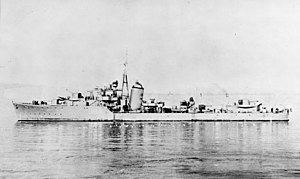Name Noble Completed 20 February 1942 Name Van Galen Launched 17 April 1941 Draft 3.81 m | Laid down 10 July 1939 Construction started 10 July 1939 Length 99.5 m | |
 | ||
Builder | ||
HNLMS Van Galen was a N-class destroyer built for the Royal Navy during the Second World War and transferred to the Royal Netherlands Navy shortly after completion.
Contents
Description
The N-class destroyers were repeats of the J-class, except that they incorporated the wartime modifications made to the earlier ships. They displaced 1,773 long tons (1,801 t) at standard load and 2,384 long tons (2,422 t) at deep load. The ships had an overall length of 339 feet 6 inches (103.5 m), a beam of 35 feet 9 inches (10.9 m) and a deep draught of 12 feet 6 inches (3.8 m). They were powered by Parsons geared steam turbines, each driving one propeller shaft, using steam provided by two Admiralty three-drum boilers. The turbines developed a total of 40,000 shaft horsepower (30,000 kW) and gave a maximum speed of 36 knots (67 km/h; 41 mph). The ships carried a maximum of 491 long tons (499 t) of fuel oil that gave them a range of 5,500 nautical miles (10,200 km; 6,300 mi) at 15 knots (28 km/h; 17 mph). The ship's complement was 183 officers and men.
The ships were armed with six 4.7-inch (120 mm) Mark XII guns in twin mounts, two superfiring in front of the bridge and one aft of the superstructure. The aft torpedo tubes were replaced by a single QF 4-inch Mk V anti-aircraft gun. Their light anti-aircraft suite was composed of one quadruple mount for 2-pounder "pom-pom" guns, four single Oerlikon 20 mm cannon and two twin mounts for the 0.5 inch Vickers Mark III anti-aircraft machinegun. The N-class ships were fitted with one above-water quintuple mount for 21-inch (533 mm) torpedoes. The ship was fitted with two depth charge throwers and one rack for 45 depth charges.
Construction and career
Van Galen was built as the British destroyer HMS Noble (G84), but was commissioned into the Royal Netherlands Navy shortly after completion. The ship served throughout the Second World War and was stricken in October 1956 and scrapped in February 1957 in the Netherlands.
